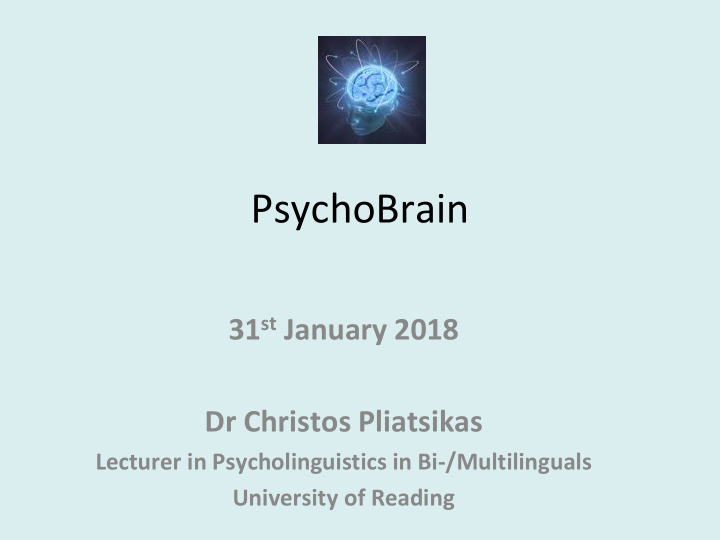



PsychoBrain 31 st January 2018 Dr Christos Pliatsikas Lecturer in Psycholinguistics in Bi-/Multilinguals University of Reading
By the end of today’s lecture you will understand • Structure and function of the brain • Methods used to study the brain
The Brain • Grouping of nerve tissue within the skull • Weighs around 1.4kg • Creates consciousness, judgment, thought, memory and emotion • Heads the nervous system that allows our body to complete basic functions that keep us alive
What’s in your head?
Hemispheres of the Brain Divided into 2 almost Identical Halves: Cerebral Hemispheres Covered by three membranes (meninges) a) Dura b) Arachnoid c) Pia
Hemispheres linked by two bundles of fibres (white matter): -Corpus Callosum -Anterior commissure
Some neuroanatomy • Grey matter (GM): The collection of the brain’s cell bodies http://users.tamuk.edu/kfjab02/Biology/AnimalPhysiology/B3408%20Systems/syst ems%20images/neuron.png.jpg • White matter (WM): The collection of the brain’s axons 7 http://www.medinewsdigest.com/wp-content/uploads/2011/12/Brain_Cortex_Harvard.png
Organisation of the cerebral cortex ‘higher’ functions
The Senses • Information from sensory organs received by: – Primary visual cortex – Primary auditory cortex – Primary somatosensory cortex (taste, touch) – Gustatory (taste) and olfactory (smell) cortices – Associations between sense organs and cerebral cortex are ‘contralateral ’
Control of movement – Different parts of the primary motor cortex are connected to muscles in different parts of the body – Associations are contralateral too
Motor and sensory areas
Cortical specialisation and brain plasticity • The functional specialisation of the cortex is not necessarily static • The role of specific regions can be “reassigned” • For example: • Patients with stroke: Initial inability to speak (“aphasia”), which improves with time and therapy. Why? • Regions near the ones destroyed “take over” the functions of speaking • Congenitally blind people show activation of the occipital cortex for tactile “Braille” reading • An otherwise unused brain region takes over for a newly acquired skill
Discuss People use 10% of their brain Myth!
Studying the brain • Accidental damage – e.g. Phineas Gage • Stroke, e.g. Broca’s & Wernicke’s regions • Brain surgery • Non-invasive recording techniques e.g. EEG, fMRI • Non-invasive neurostimulation, e.g. TMS
Lesion studies • Initially the only available method to study the functions (or lack of) of the brain. – The “ anatomo- clinical” method: Patient behaviour was observed and recorded, and linked to brain damage post-mortem. • Paul Broca (1861): – One of his patients had problems in speaking – Only simple syllables could be produced (“tan”) – Post-mortem analysis revealed extensive damage in a posterior area of the Left Inferior Frontal Gyrus (LIFG) – The area was named after Broca – It has been known to be crucial for speech production
Brain surgery Corpus callosotomy – severing corpus callosum ‘split - brain’ patients - information cannot be passed between hemispheres
Visual-field studies • Fixate on central point, present stimulus to one visual field • Information from left visual field goes to right hemisphere and vice-versa • In ‘split - brain’ patients, information cannot pass between hemispheres Image: http://wps.prenhall.com/hss_wade_mru_2/0,7992 ,823168-,00.html Accessed 6/11/5
Image: http://slideplayer.com/slide/8396581/ http://www.youtube.com/watch?v=lfGwsAdS9Dc
Discuss There are right- and left-brained people Myth! • This visual illusion supposedly tells you whether you are right or left brained: – http://www.youtube.com/wat ch?v=ilaHDcfA9Eg&feature=re lated – See if you can change the direction of the dancer
Non-invasive recording • Measuring Electrical Activity: EEG: Electrodes attached to the scalp and record electrical activity (action potentials from groups of neurons) • Looking at the Whole Brain (Imaging): fMRI: Detecting which particular brain areas are involved in particular types of processing • Brain Stimulation: TMS: Potentials are triggered at specific brain areas to define their function
Modern EEG recording Brain activity measured by electrical impulses is now recorded and analysed using computers
Magnetic Resonance Imaging (MRI) • Uses magnetism to build up a picture of the inside of the body. • 3D representation of the brain • functional MRI (fMRI): Looking at localisation of brain function in real time – Brain activity as a response to specific stimuli – The more active the neurons become, the more blood is needed • Pliatsikas et al.(2014a): Brain regions activated for the processing of grammatically complex words – E.g. played (play + ed)
Magnetic Resonance Imaging (MRI) • Structural MRI: Looking at the brain’s structure – Similar methods and identical equipment to fMRI – Looking at structural effects in the brain – Grey and white matter – Pliatsikas et al. (2014b): Cerebellar volume in non-native speakers correlates with how fast they are in a grammatical task.
Transcranial magnetic stimulation (TMS) Strong magnetic field creates electrical currents in the brain Can target cortical areas as small as 1 cm 2 Those currents can cause or disrupt a function • Visual: phosphenes • Language: speech arrest
Discuss There are male brains and female brains http://www.helloquizzy.com/quizzy/take Myth!
Thank you! https://christoslab.wordpress.com/ @Christos_lab https://www.facebook.com/bilingualisminthebrainlab/ c.pliatsikas@reading.ac.uk 26
Recommend
More recommend